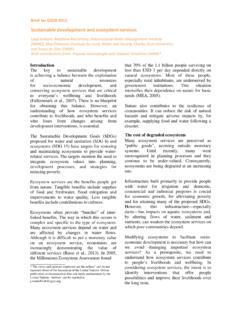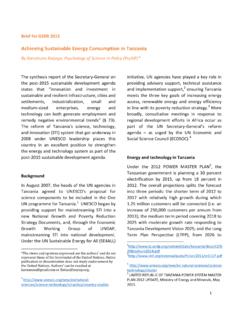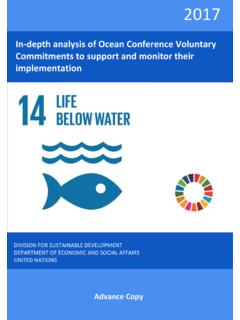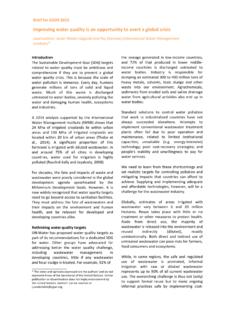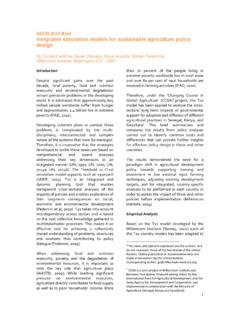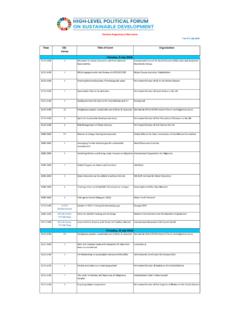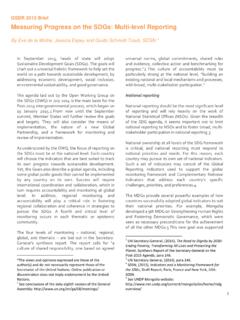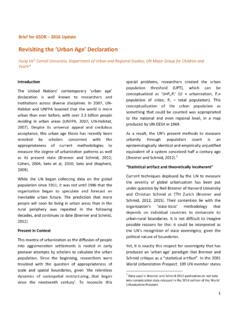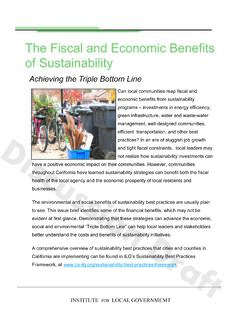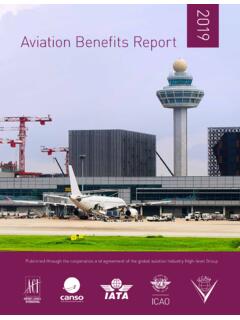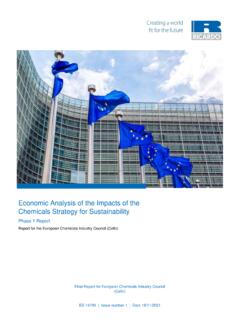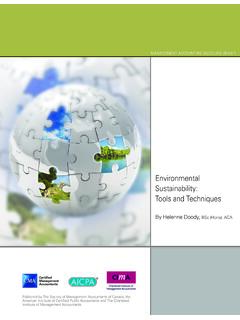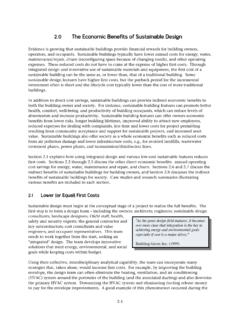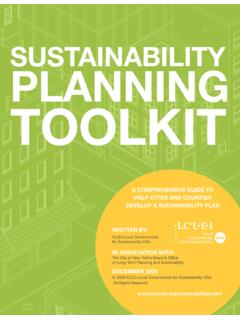Transcription of ENVIRONMENTAL AND SOCIAL SUSTAINABILITY
1 A Framework for Advancing ENVIRONMENTAL AND SOCIAL SUSTAINABILITY in the United Nations SystemUNITED NATIONS 2012 United NationsAll rights reserved worldwideRequests to reproduce this publication in whole or in part should be sent to DisclaimerThe designations employed and the presentation of the material in this publication do not imply the expres-sion of any opinion whatsoever on the part of the United Nations concerning the legal status of any country, territory, city or area or of its authorities, or concerning delimitation of its frontiers or boundaries. Mention of a commercial company or product does not imply endorsement by the cooperating partners. The views ex-pressed do not necessarily represent the decision or the stated policy of the United Nations nor does citing of trade names or commercial processes constitute endorsement. Printed on recycled FRAMEWORK FOR ADVANCING ENVIRONMENTAL AND SOCIAL SUSTAINABILITY IN THE UNITED NATIONS SYSTEMP repared by Environment Management GroupUnited Nations, Geneva, 20125 Table of Content: ForewordPrefaceJoint Statement by Executive Heads of EMG MembersExecutive summaryIntroduction Chapter 1 Towards a common ENVIRONMENTAL and SOCIAL SUSTAINABILITY framework Chapter 2 Context for a system-wide ENVIRONMENTAL and SOCIAL SUSTAINABILITY framework Chapter 3 Key findings from the inter-agency review on ENVIRONMENTAL and SOCIAL SUSTAINABILITY Chapter 4 Future considerations for a common ENVIRONMENTAL and SOCIAL SUSTAINABILITY frameworkAnnex A: Minimum requirements for a system-wide ENVIRONMENTAL and SOCIAL SUSTAINABILITY frameworkAnnex B: United Nations entities and institutions employing SUSTAINABILITY systemsAnnex C.
2 World Health Organization case study: Development of an ENVIRONMENTAL and SOCIAL SUSTAINABILITY systemAnnex D: List of review intervieweesAnnex E: Examples of the founding documents and principles of existing ENVIRONMENTAL and SOCIAL SUSTAINABILITY systemsAnnex F: ContributorsAbbreviations and AcronymsMembership of the Environment Management Group 6 7 9 1012172533434951555758646 ENVIRONMENTAL AND SOCIAL SUSTAINABILITY Foreword by the United Nations Secretary-General The global population has reached 7 billion. In just five years, we will add another half billion people all needing food, jobs, security and opportunity. Yet ENVIRONMENTAL , economic and SOCIAL indicators tell us that our current model of progress cannot be development offers the best chance to adjust our course. That will mean doing far more to connect the dots among the main challenges the world faces today: water, food and energy security, climate change, poverty, inequality and the empowerment of the world s Nations agencies, funds and programmes are working to create a sustainable future the future we want.
3 But even as we dispense aid and advice to others, we have to recognize that we, too, are part of the picture. How we make policy, develop programmes and oversee our facilities must also be viewed through the lens of SUSTAINABILITY . This report is the product of inter-agency consultations aimed at ensuring greater ENVIRONMENTAL and SOCIAL SUSTAINABILITY in our work. The report notes that while many individual United Nations entities have adopted assessment policies and practices, the United Nations System acting together can do even more, including by developing a common SUSTAINABILITY framework and relevant Framework for Advancing ENVIRONMENTAL and SOCIAL SUSTAINABILITY in the United Nations System will greatly assist in this effort. It coincides with the run-up to the Rio+20 United Nations Conference on Sustainable Development, a major opportunity to reinvigorate this cause.
4 And it follows the January 2012 release of the report of my Global SUSTAINABILITY Panel, which has put forward a wide range of important recommendations, including to strengthen the United Nations System s own sustainable development ENVIRONMENTAL , SOCIAL and economic SUSTAINABILITY practices can make us a more efficient, effective and responsible organization. I am strongly committed to this agenda and look forward to working with all partners within and beyond the United Nations to achieve a sustainable and equitable future for Ki-moonUnited Nations Secretary-General7 Preface by the Chair of the Environment Management Group In order to meet the ENVIRONMENTAL , SOCIAL and economic challenges of a new century the United Nations needs to find improved ways of identifying the full benefits and costs of the decisions it United Nations has a long history of advocating for ENVIRONMENTAL and SOCIAL responsibility: this is now evolving into a unifying platform that will strengthen the SUSTAINABILITY of its administrative and operational choices.
5 For the past two years an inter-agency initiative to advance ENVIRONMENTAL and SOCIAL SUSTAINABILITY in the United Nations System has been exploring this issue, under the guidance of the ENVIRONMENTAL Management Group. This report backed up by a SUSTAINABILITY Framework will allow the United Nations to broaden its traditional and sometimes isolated ways of working in order to better understand how the complex suite of activities taken across the organization influence one another in terms of impacts and ENVIRONMENTAL and SOCIAL SUSTAINABILITY initiative will in addition assist the United Nations to collectively measure progress towards SUSTAINABILITY as an institution, and to better see the risks and opportunities. It also allows us to learn from each other s experiences, capture institutional knowledge and work together for the results required.
6 A system-wide approach will ensure a United Nations-wide commitment to integrate simultaneous economic , ENVIRONMENTAL and SOCIAL impact assessments in major policy and decision-making processes. No other international institution has put forth an ENVIRONMENTAL and SOCIAL assessment initiative as holistic and inclusive as this one. Rio+20 under the themes of a Green Economy in the context of sustainable development and poverty eradication and an institutional framework for sustainable development is an opportunity for the United Nations to exhibit its commitment and leadership in taking this effort is a work in progress. Some of the next steps include the inter-agency process continuing its consultative work. This will focus on evolving the policy-level framework into an implementation phase that all United Nations entities can take forward in a flexible and phased approach.
7 To be a credible institution, what we ask of others, we must do ourselves. To be a leader, we must go further and support ways in which we can continuously learn from our work and each SteinerExecutive Director, Environment Management Group8 ENVIRONMENTAL AND SOCIAL SUSTAINABILITYH aitian students breathe new life into depleted pine forest, Haiti. UN Photo / Logan Abassi9 Joint Statement by Executive Heads of EMG Members on Advancing ENVIRONMENTAL and SOCIAL SUSTAINABILITY in the United Nations System We, the Executive Heads of Agencies, Funds, Programmes and Departments of the United Nations,Are convinced that the promotion of human well-being and global SUSTAINABILITY hinges on ENVIRONMENTAL protection and SOCIAL and economic development, Bear in mind the responsibility of the United Nations System to embody the internationally accepted ENVIRONMENTAL and SOCIAL principles in its internal management as well as to support their application by partners and stakeholders.
8 And the need to reduce risks and unintended negative impacts, and maximize benefits to people and their environment in a coherent and integrated way within the United Nations System,Are conscious of the efforts by those United Nation System entities that have already developed ENVIRONMENTAL and SOCIAL safeguards to mitigate the ENVIRONMENTAL and SOCIAL impacts and risks of their activities before the adoption of a common approach to advancing ENVIRONMENTAL and SOCIAL SUSTAINABILITY in the United Nations System, Are mindful of the need for the United Nations System to internalize the internationally agreed norms of the SUSTAINABILITY agenda at the level of policy/strategy, programme/project and facilities/operations management through a common framework for ENVIRONMENTAL and SOCIAL SUSTAINABILITY , including through safeguards, risk management, institutional learning, capacity-building, simplification, coherence and transparency,Are recognizing the wealth of experience across the United Nations System to ensure the ENVIRONMENTAL and SOCIAL impacts and risks of activities are well managed, which has informed the development and adoption of this common approach, We hereby commit ourselves, proceeding in a phased manner, to use the Framework for Advancing the ENVIRONMENTAL and SOCIAL SUSTAINABILITY in the United Nations System annexed to this statement (see chapter 1) as a means of furthering the organization s SUSTAINABILITY performance, including by.
9 Moving our respective organizations towards strengthening ENVIRONMENTAL and SOCIAL SUSTAINABILITY in our activities, and endeavouring to find the necessary resources to real-ize the increased efficiency and operational safety gains of such a common approach. Supporting the further development and implementation of a United Nations System-wide framework for ENVIRONMENTAL and SOCIAL SUSTAINABILITY including ENVIRONMENTAL and SOCIAL safeguards; for monitoring collective efforts; and for reporting back to the Governing Bodies of our respective organizations on progress made, good practice and lessons make this commitment with a view to show leadership by increasing institutional account-ability for the ENVIRONMENTAL and SOCIAL SUSTAINABILITY of our activities. We do this to further enable the United Nations System to work smarter and safer, respond more effectively to emerging issues and stakeholder needs and better harness lessons from shared AND SOCIAL SUSTAINABILITY Executive Summary The ENVIRONMENTAL and SOCIAL SUSTAINABILITY Framework strives to carry the institution beyond the typical safeguard measures of do no harm to identify ways to do good.
10 In the spirit of One United Nations, the Framework takes a holistic view of the organization s work from policy conception through programme implementation and internal operations management, providing a broader base of knowledge for smart decision-making. The initiative looks to build on the internationally agreed SUSTAINABILITY norms and principles of the last 30 years by adapting the best practices of ENVIRONMENTAL and SOCIAL assessment procedures and management systems to United Nations System activities. This effort started when the Senior Officials of the Environment Manager Group (EMG) decided at their fifteenth1 meeting in September 2009 to undertake a consultative process and prepare a report that outlines options for a common United Nations System approach for ENVIRONMENTAL and SOCIAL safeguards . The opportunity to explore options for advancing United Nations SUSTAINABILITY was welcomed in response to several requests raised by EMG members in the lead-up to the meeting.
